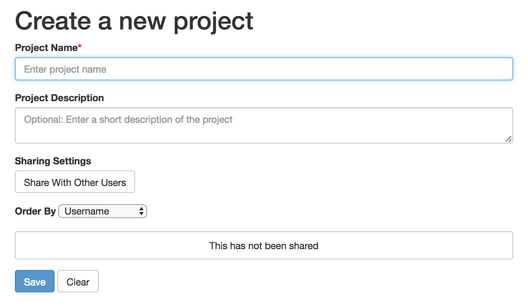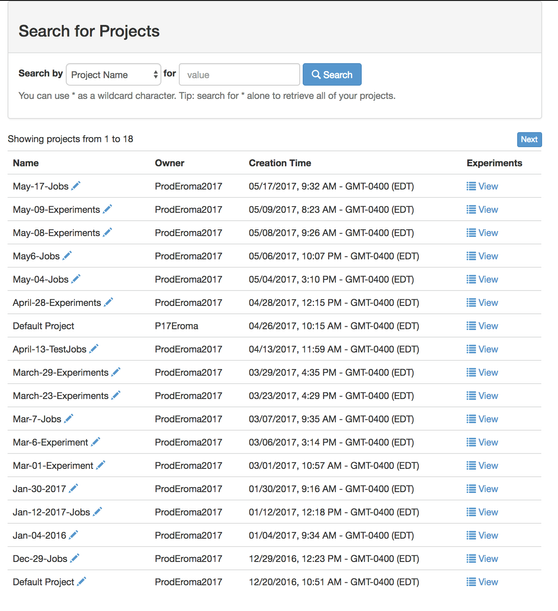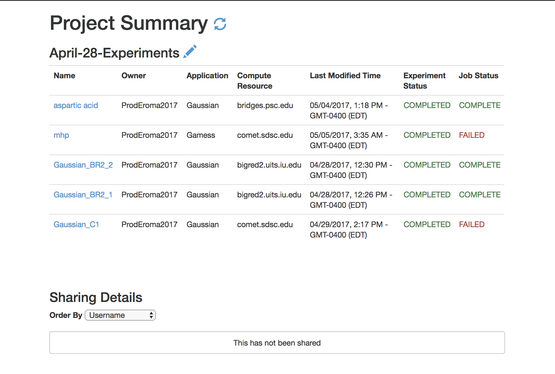Introduction to SEAGrid Gateway
Hosted SEAGrid portal is the UI developed by the Airavata team for interested science communities to work with. This user guide provides step-by-step information on obtaining a complete science gateway experience for science and scholarly communities using Airavata as a middleware platform. In the user guide we would also discuss main features and services provided for gateway communities via Airavata.
User guide will tell you;
How to register users in the portal.
What are projects and how to use them.
How to create, launch and monitor experiments.
Sharing your work with others.
Using own allocation for job submissions in compute resources.
How to get help, provide feedback and request for new applications.
For more details on Airavata middleware visit Airavata site
Gateway Details
- Hosted SEAGrid Gateway link;
https://seagrid.org/ - Download application input files from;
Sample application input files I
Sample application input files II
Tutorial I - Gateway Login
Create Account
- A new user has to create an account using ‘Create account’ link on top right hand corner of the gateway.
- To create an account;
- Please enter mandatory information and submit. A confirmation message will confirm the creation.
- Important;
- Username cannot have spaces.
- Username & password must be longer than 5 characters.
- Password is case sensitive, need at least one number, one special character (!@#$%), at least one upper case letter and one lower case letter.
- Enter all the mandatory fields indicated by a star; *.
- Account creation page: https://seagrid.org/create
Account Confirmation and Verification
Once the account is created you will receive an email to confirm the account creation.To confirm use the link provided in the email and follow given instructions.
Till the gateway administrator verifies and enable the account; you will not be able to submit jobs on compute resources.
Once the account is enabled the account owner will receive an email notification on new gateway privileges.
Gateway admin might even contact the user over email to get more information on research interests in order to assist the user.
Login to Account
- Once the account is created successfully; login to the gateway using the created account.
- Gateway login screen link
- OR use the 'Log In' link given on the 'Create New Account' page after account retain is successful.
- Login Page;
Image I - Login
Tutorial II - Use Projects
Use Project
- Projects are used to group experiments, they are containers. Experiments in the gateway has one to one mapping with jobs launched to compute resources.
- To create Projects, navigate to ‘Project --> Create’ from the main menu.
- Enter required mandatory information and Save.
- Project creation Screen
Image II - Create Project - While creating the project user can share the project with other gateway users.
- Upon saving you will be navigated to Project Summary page.
Browse Projects
- Screen navigation 'Project --> Browse' from the main menu.
- Search for projects using name or description
- Search Project Page;
Image III - Search Project - All the projects matching your search criteria will be listed.
- User can search for all projects by using (*) as a wild character. The * can be used when searching either options; project name or description.
- When projects are listed by clicking ‘View’ at the end of the row user can navigate to ‘Project Summary’ page; this page displays all experiments in the project. User can click on an experiment name and navigate to ‘Experiment Summary’ page.
- To traverse through existing projects use 'Next' button on top of the list on right.
Image IV - Project Summary
Edit Projects
- Existing projects can be modified. The name, description can be changed.
- Project sharing can be changed as well. Project owner can add or remove the shared users.
Tutorial III - Create & Launch Experiment
Create Experiment
- To create an experiment; Navigation Experiment --> Create Experiment
- Create Experiment Page - Experiment Information
Image VI - Create Experiment - Initially user need to enter/select given fields in order to continue.
- Experiment Name (Mandatory)
- Experiment Description (Optional)
- Project (Select from the available LOV)
- Application (Select from the available LOV)
- Then continue entering Application configuration information.
- Experiment application input (Mandatory) - Application input can be in the form of entering data manually or uploading a single or multiple files.
NOTE: Uploading file validity is not checked by the gateway. User has the responsibility of uploading correct files. - Compute Resource (select from the available LOV)
- Node Count
- Total Core Count
- Wall Time Limit
- Experiment application input (Mandatory) - Application input can be in the form of entering data manually or uploading a single or multiple files.
- NOTE:
- For values c, d and e if user does not enter, default value will be taken as the input.
- For c and d user has to enter a value greater than or equivalent to 1.
- For e user has to enter a value greater than or equivalent to 0.
- Values to c and d could be decided sometimes based on the application or/and resource. Inserting the accurate values are currently in the hands of the user.
- Create Experiment - Application Configuration Part
Image VII - Create Experiment Contd.. - While entering application configurations user can start over from the beginning using ‘Start Over’ button.
- Once saved or Saved and launched user will be directed to ‘Experiment Summary’ page; can refresh the page and monitor experiment status changes.
- Experiment Summary Page
Image VIII - Experiment Summary
Launch Experiment
To launch an experiment can use the same 'Create Experiment' screen. Apart from saving the experiment user can Save & Launch at the same time using button ‘Save and Launch’.
User can also create and save the experiment to launch later. To launch later user has to navigate to 'Experiment Summary' Page.
If the experiment is not suppose to be launched e.g.: a COMPLETED, LAUNCHED experiment, then the launch button will be disabled.
Tutorial IV - Browse Experiments
User can search for experiment created by him/her through
Experiments → Browse
Browse Projects → View Project → View Experiment (by clicking on the status of the experiment) - Please refer Search Projects in Tutorial II above.
In Search Experiments search keys are;
Experiment Name
Experiment Description
Application
…
Browse Experiments Page
Image IX - Search Experiments
All the experiments of the user will be listed; latest on top. User can also select the search by key, user has to give a value to search for using the key. Partial values, complete values, (*) wild card can be used to search.
Click on Search once the search key is selected and value is entered. User can also search for experiments by giving the status.
All the experiments as per entered Key value pair will be listed.
By clicking on the 'Status' user will be navigated to ‘Experiment Summary’ screen of each experiment.
In experiment summary users can;
Launch experiment - Explained in above Tutorial III
Cancel experiment
Clone experiment
Edit experiment
User can edit an experiment by navigating to 'Edit Experiment' page. Edit button next to each experiment name will navigate user to 'Edit Experiment' page of each experiment.
Tutorial V - Modify, Cancel & Clone Experiments
Modify Experiment
Modify experiment by clicking on the edit icon (pencil) next to experiment name OR by clicking on ‘Edit’ button in Experiment Summary Page.
User can modify all available fields except experiment status, application & experiment ID.
User can update experiments with statuses;
CREATED
VALIDATED
Edit Experiment Page
Image X - Edit Experiment
Cancel Experiment
- Experiments can be canceled by navigating to experiment’s 'Experiment Summary’ screen.
- Experiment statuses which allows cancellations;
- LAUNCHED
- EXECUTING
- SCHEDULED
- Click on ‘Cancel’ button and immediately the Experiment status will change to CANCELING.
- If the job is not already processing in the remote resource the job will proceed to COMPLETE and upon completing the experiment status will change to CANCELLED. Since the user requested a cancellation generated output will not be provided back to the gateway.
- If the job was successfully CANCELLED upon changing the job state to CANCELLED experiment status will also change to CANCELED.
- CANCELED experiments are only available for cloning in the PGA.
Clone Experiment
Experiments can be cloned irrespective of the experiment status by clicking ‘Clone’ in ‘Experiment Summary’ page.
When clicks ‘Clone’ from experiment summary user will be navigated to ‘Edit Experiment’ page of the new experiment. The new experiment will have exact same information as the earlier existing experiment.
The new experiment will have a new experiment ID and the status will always be CREATED.
New experiment name = Clone of + Old experiment name
User can change existing information in ‘Edit Experiment’ page and save or save & launch.
Tutorial VI - User Assistance
Report Issue
Gateway user can report issues faced within the gateway through this page.
Page navigation: Help → Report Issue
Raise a Bug Page
Image XI - Raise a Bug
Request Feature
Gateway allows users to provide feedback as well as request for new applications via Request Feature Page.
Page Navigation; Help → Request Feature
Got Feedback? Page
Image XII - Got Feedback?





